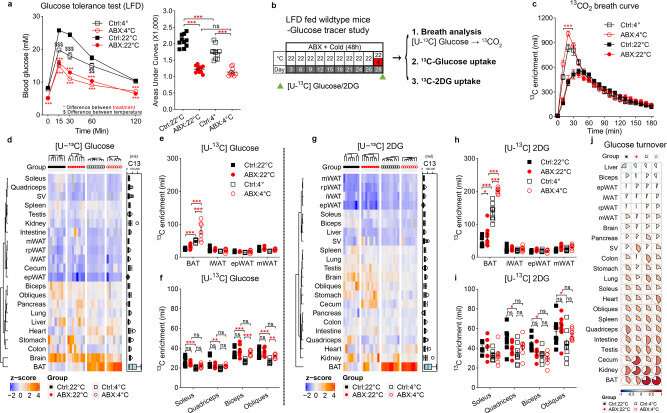The role of gut-brown adipose tissue axis in regulating glucose metabolism

A recent study conducted by Prof. John Speakman's lab at the Institute of Genetics and Developmental Biology (IGDB) of the Chinese Academy of Sciences shed a new light on the important role of gut-brown adipose tissue axis in regulating glucose metabolism.
In the last two decades it has become clear that the bacteria in our guts isn't there just to digest food. It seems to play an important role in all sorts of physiological processes. One intriguing observation made a few years ago is that if the bacteria in the guts of mice are killed using an antibiotic cocktail then their ability to dispose a glucose bolus is actually improved. Since poor ability to clear glucose is related to the risk of developing diabetes this observation has been seen as a potential way to understand how glucose clearance ability might be improved.
Mice like most mammals have two types of adipose tissue—brown and white. Brown fat burns energy while white fat stores it. However, there are some cells which can flip between being white and being brown. As more cells in white adipose tissue become brown then in theory that tissue should have greater capacity to utilize glucose. Previous work showed that when you kill the gut bacteria the white adipose tissue gets browner. Another study suggested that the greater glucose disposal might be happening in the liver.
One problem with these previous studies is that they didn't actually measure the uptake of glucose into different tissues. The changes were just inferred from gene expression changes in different tissues. Plus, they were selective in what tissues they looked at. Put simply, if you only check the effects on white adipose tissue you will only ever find out that white adipose tissue is affected.
In the new study, Speakman's lab in Beijing used isotopic traces to look at glucose uptake across all the tissues and then compared which ones changed when the microbiota was killed.
The researchers used 13C-glucose combined with mass spectrum to do the glucose tracing and revealed that there were only very minor changes of glucose uptake in the liver and white adipose tissue but the largest impact was actually in the brown adipose depots.
They then went on to investigate the importance of a key gene expressed in brown adipose tissue that uncouples respiration and leads to heat generation-called uncoupling protein 1 (UCP1).
Using mice without UCP1, the researchers treated UCP1-knockout mice with antibiotics found no effect on the improvement of glucose clearance by antibiotic cocktails (ABX) treatment, which suggested the improved glucose clearance and glucose uptake by gut microbiota deletion is dissociated from the heat producing functions of brown adipose tissue.
Finally, the researchers used a mouse with diphtheria toxin receptor on cells expressing UCP1 to show that while knocking out UCP1 had no effect on the improvement, actually killing the brown adipocytes did, suggesting the indispensable role of brown adipocytes in the improved glucose clearance.
More information: Min Li et al, Brown adipose tissue is the key depot for glucose clearance in microbiota depleted mice, Nature Communications (2021). DOI: 10.1038/s41467-021-24659-8
Journal information: Nature Communications
Provided by Chinese Academy of Sciences



















